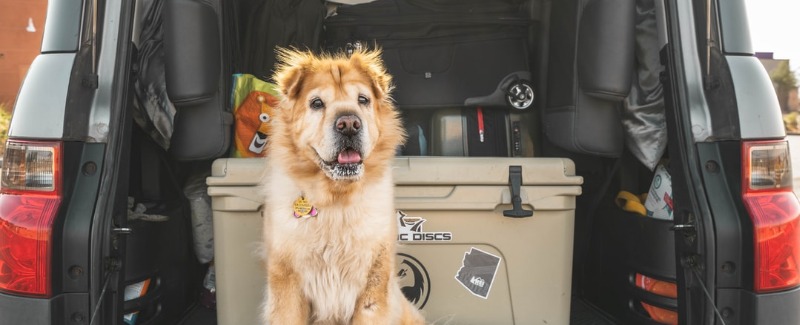If you’re one of millions of people who travel with your dog, you’ll not only want to travel safely, but you’ll also want to make your trips as pleasurable for yourself and your canine companion as possible. Along with being fun and exciting, being away from home can also be stressful, but there are some simple steps you can take to make your trips enjoyable and relaxing.
There are a plethora of pet-friendly hotels, excellent technology for making travel safer and easier, and an increasing number of people and places that appear to understand that having a dog along is perfectly acceptable — in short, traveling with your dog has never been easier or more pleasurable. However, traveling with your dog isn’t just for vacations; it may also be as mundane as driving to the veterinarian’s office, the groomer, or any other place you need to transport your dog on a daily basis. The truth is that if your dog isn’t a good traveler, none of this will be easy or fun.
Traveling Safely
Contents
Your first consideration when traveling with your dog is safety. If you are going to travel by car, your dog will need to be safely restrained for the ride. Think it looks cute to see a little dog riding on the driver’s lap, with the dog’s front feet on the door, ears blowing in the breeze? Every year, hundreds of dogs are injured or killed when they are thrown out of the open windows they’re half hanging out of, sometimes with their owners still holding the leash.
If possible, bring several days’ supply of water from home, along with your dog’s food to minimize the possibility of digestive upset. If your dog does have a bit of loose stool from dietary change or stress, a spoonful of canned solid pumpkin (not pie filling) added to a couple of meals will usually firm the stool up quickly, with no negative side effects.
Your dog should not ride sitting on someone’s lap, and especially not in the front seat, where he’s not just a potential distraction or hazard for the driver; he’s also a potential projectile in an accident or during sudden braking or turning. The safest way for your dog to ride in the car is in a crate, but a seat belt is the next best thing.
If you are flying with your dog, or you are crossing state or international borders, your dog will need a health certificate from your vet before your trip. You will also want to make sure you bring a copy of your dog’s rabies vaccination and license certificates, and prescriptions for any medications your pet is on, just in case. No matter how you travel, you’ll want to make sure your dog is always wearing a well-fitting collar (that he can’t slip out of) and is always leashed in unfenced areas. You can use a longline or retractable leash to give him some room to stretch his legs, but even trained dogs shouldn’t be off leash in unfamiliar or unsafe (highway rest stops come to mind) areas.
Flying with your dog can be nerve-racking, particularly if your dog is too big to fly in the cabin with you. You can breathe a little easier if your dog is small enough to fit in one of the widely available under-seat carriers. Whether your dog is able to fly in the cabin or not, it is not recommended to tranquilize your dog prior to flying. It depresses the respiratory system, and your dog needs to be able to pant to help regulate his body temperature.
A dog lost in unfamiliar surroundings might never be recovered. A properly fitting collar, with your current phone number (cell is often best), along with permanent identification like a microchip, can help your lost dog find his way home. If your dog is chipped, add the phrase “ID by microchip” to the tag instead of your address.
Most airlines will not fly animals in extreme weather conditions, so make your travel plans accordingly. If your dog does end up flying down below, there’s nothing wrong with waiting until you’re absolutely sure your dog is on the plane before you board. You should also always try to get nonstop flights when traveling with your dog, but if you must change planes, make sure that your dog makes it on the next leg of the flight with you before the plane takes off. The large majority of dogs make it to their destinations just fine, but it never hurts to make sure your precious cargo is okay.
Pet-friendly Destinations
Maybe you’re lucky and have access to pet-friendly destinations already, but if you’re creative, you can find a variety of travel and vacation options to meet practically any interest and budget. For outdoorsy types, camping is fun, and leashed dogs are welcome at many privately owned campgrounds, as well as at some state and national parks. If you’re not into the idea of roughing it, pet-friendly lodging is available in every variety, from the most basic motor lodges, to intimate bed-and-breakfasts, to the most cosmopolitan hotels in large cities. If you’re determined to bring your dog with you on vacation, do you have a plan for what your dog will do when you’re visiting local attractions? Some of the larger hotels offer dog-walking services, but you may want to arrange for day care in the area if you’re going someplace your dog isn’t allowed.
Finding Dog-Friendly Lodging
It’s a nice feeling to get into your car, packed and ready to go on vacation, and know you don’t have to leave your dog at a kennel or other boarding facility. Instead of worrying about how he’ll be treated while you’re gone, you may look forward to sharing your adventures with him. Whether you prefer a tent over a sleeping bag or a suite at a five-star hotel, it is not difficult to locate a place that will welcome you and your dog at any price point.
While there are many wonderful places to stay with your dog, don’t assume that any place you choose will be pet-friendly. Some establishments that accept small dogs will not accept larger dogs or multiple pets. Always do your homework ahead of time, phone the hotel, and inquire about their pet policy. Make an appointment. This provides you with the protection you require when traveling with your dog. You don’t want to arrive and find the place completely booked, even though it’s their slow season. You can also specify the type of accommodation you desire, such as a first-floor room with direct outside access.
There are guidebooks available that list pet-friendly motels around the United States, and they can be quite useful. Searching the Internet is also a fantastic approach to see what’s available. Check all listings thoroughly; pet rules at hotels and motels can and do change on a regular basis.
Airline Travel
Is it safe to take your dog on a plane? It’s as safe for you as it is for me — albeit not as comfy. Unless you have a very little dog that can be transported into the cabin in an approved carrier, your dog must be crated and placed in the luggage section. Before you even think about doing something, you should conduct a lot of research. Most domestic and major international airlines in the United States have policies in place to make pet transportation as safe as possible. You should read them, compare them, and try to talk to people who have done it before. Owners of champion show dogs frequently fly to the largest exhibitions in the country and around the world.
The airlines’ policies also specify the type of carrier that can be used to transport your dog, what can be contained inside it, how it should be labeled, and so on. A dog that hasn’t been crate-trained is in for a rough time. Even a dog who is accustomed to sleeping in his crate at home may find the experience upsetting.
If you have a huge dog, chances are you won’t be allowed to travel by train, bus, or boat with him – but it’s worth checking! If you plan to or need to take your dog on a train or a bus somewhere, try to find out ahead of time if your dog is welcome.
As of this writing, cruise lines do not allow dogs onboard. They typically pass into international waters, where quarantines and other rules make accommodating dogs prohibitively difficult. It’s possible to discover dog-friendly charter companies or sightseeing trips, but it’ll require some digging.





